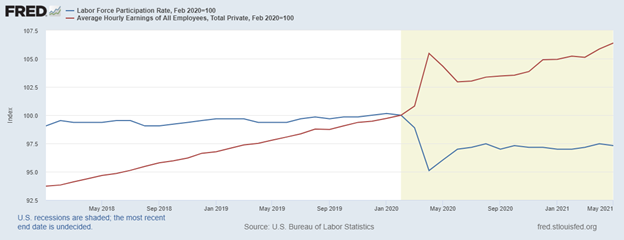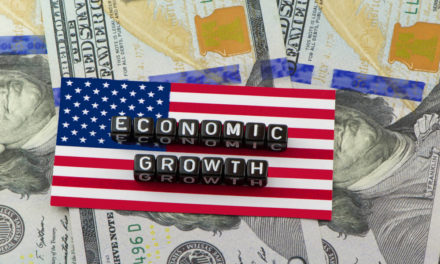Last week’s unemployment report led to a predictable response.
Some argued that unemployment is higher than it should be because enhanced unemployment benefits make it more lucrative for some potential workers to stay at home. Others argued higher wages are needed to make work more attractive.
Both arguments have strong appeals to emotions. For some, the emotional appeal of their argument is more important than hard numbers. The facts show that jobs are hard to fill, but higher wages almost certainly aren’t the answer.
The chart below looks at the trends in wages and labor force participation over the past five years.
While Wages Spiked, Labor Force Participation Plummeted

Source: Federal Reserve.
COVID Might’ve Balanced Labor Force Participation Rate
Wages (the red line) were rising before the economy shut down last year. But labor force participation (the blue line) was flat over that time.
The labor force participation rate is the percentage of people at least 16 years old that are either working or actively looking for work. Economists think of it as an important number for the economy since it shows how much labor is available to produce the goods and services that define economic output.
Labor force participation rose from less than 59% in 1965 to more than 67% in 2000. But participation has been in a downtrend this century. Before the economy shut down, the participation rate was at 63.4%. It fell as low as 60.2% in April 2020 and has rebounded to 61.3%.
Participation should never be 100%. There will always be some potential workers who choose not to work to attend college or raise families. Others will be unable to work because of disabilities. No matter how high wages are, some of these people will prioritize other things over employment.
Economists don’t know what the right level is — but it’s unlikely we return to the old highs of 67% in the current economy. The labor force participation rate, as is, might actually be about right. The sharp drop in early 2020 might have accelerated the 20-year downtrend and pushed the labor market into equilibrium.
I don’t like working more than I have to.
That’s why I found a way to beat the market by making one simple trade per week.
Last year, this trade helped me beat the market eight times over.
It’s a great way to accelerate your gains. Click here, and I’ll show you how it works.
Michael Carr is a Chartered Market Technician for Banyan Hill Publishing and the Editor of One Trade, Peak Velocity Trader and Precision Profits. He teaches technical analysis and quantitative technical analysis at the New York Institute of Finance. Mr. Carr is also the former editor of the CMT Association newsletter, Technically Speaking.
Follow him on Twitter @MichaelCarrGuru.





